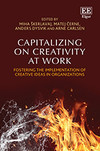 In less than a decade, Talking Tom and friends have become a household name around the world with number of downloads exceeding the global population. A fascinating story of how Outfit7, the company behind the scenes of Talking Tom has been started up, scaled up, how founders exited and how it is developing recently as one of rare entrepreneurial unicorns under the new ownership. Many thanks to my co-authors Spencer Harrison (INSEAD) and Žiga Vavpotič (Outfit7 member of the board), all the contributing interviewees including Iza Login (the founder of Outfit7), Xinyu Qian (CEO), all the participating leaders and employees from Outfit7 as well as dedicated staff from the INSEAD to get the story out in the open. Three-part case study is now available from the INSEAD case publishing, the Case centre and now also from the Harvard business school publishing. Our greatest hope is that it will spark fruitful discussions and learning in the educational institutions around the world.
In less than a decade, Talking Tom and friends have become a household name around the world with number of downloads exceeding the global population. A fascinating story of how Outfit7, the company behind the scenes of Talking Tom has been started up, scaled up, how founders exited and how it is developing recently as one of rare entrepreneurial unicorns under the new ownership. Many thanks to my co-authors Spencer Harrison (INSEAD) and Žiga Vavpotič (Outfit7 member of the board), all the contributing interviewees including Iza Login (the founder of Outfit7), Xinyu Qian (CEO), all the participating leaders and employees from Outfit7 as well as dedicated staff from the INSEAD to get the story out in the open. Three-part case study is now available from the INSEAD case publishing, the Case centre and now also from the Harvard business school publishing. Our greatest hope is that it will spark fruitful discussions and learning in the educational institutions around the world.
Abstract:
Outfit7 is a digital entertainment firm that develops and publishes animated video games for mobile phones, tablets and desktops. It’s flagship product is a series of mobile apps called “Talking Tom and Friends”, with close to 8 billion downloads globally. Outfit7 is one of only 46 European unicorns, i.e., privately held companies valued above $1 billion, topping the global ranks of most downloaded mobile games. In 2017, according to App Annie, a leading app-ranking platform, Outfit7 was the sixth most downloaded mobile publisher, and My Talking Tom was the second most downloaded mobile game globally, putting it in the company of tech giants like Facebook, Google, Tencent and Alibaba. Part A describes the growth stage from 2009 to 2014, along with the story of founders Samo and Iza Login. The focus is on setting up the startup and developing a unique organizational culture, leaving the hiring decision (fit or misfit) to students. In Part B, from 2014 to 2017, the start-up moves into scale-up phase after the founders’ exit/appointment of a new management team, the focus is on entrepreneurial leadership. In Part C, as tensions emerge from scaling up a unicorn, students must decide what to keep and what to change (how to balance continuity and renewal) as expectations for growth soar.Pedagogical Objectives:
To facilitate discussion of entrepreneurship, leadership, human resource management, change through growth, and organizational culture.Keywords:
Start-Up, Scale-Up, Entrepreneurship, Leadership, Human Resource Management, Organizational Culture, Unicorn, Founders’ Exit, Change Management, Family Entertainment, Growth, Learning from Failure, Organizational Values, Teamwork









You must be logged in to post a comment.